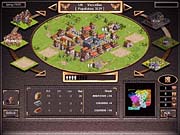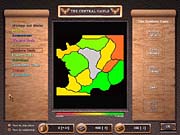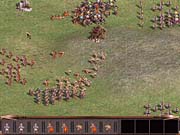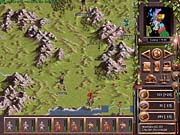Legion Preview
Rule the Roman Empire with this turn-based strategy game from Slitherine.
Two of Slitherine Strategies' founders are world champion tabletop wargamers. While that may seem like an inconsequential factoid, that history is very apparent in the company's first game, Legion. Set in the formative years of the Roman Empire, Legion is a turn-based strategy game that involves large numbers of nations and tribes in a series of historically based campaigns. While similar in some ways to Frog City's acclaimed Imperialism games, Legion promises to combine economic development, city management, and military conquest in a way that resembles tabletop board games and PC games at the same time.

Legion is made up of two primary components: city building and combat. Like the board games from which Legion draws inspiration, both areas are simple in execution but promise great room for strategic depth. The city building aspect lets you expand your city in primary ways so that you can support a larger army and expand your empire. There are three resources in the game: wood, metal, and food. Most buildings increase your production of one of the primary minerals, while others augment your production in some other way.
Building a town hall will increase the area of land you can build on, as well as increase your city's population. This gives you more people to assign as workers or to recruit into your army. Each city has a limited number of residents, making a simple yet hopefully effective balance between military might and economic production. The town hall can be later upgraded to a city hall, which adds even more land and more people. Lumber mills increase your wood production, mines increase your metal production, and farms your food production. Other buildings include the shrine, which increases the effectiveness of workers assigned to buildings and garrison buildings for civic protection. Buildings also determine what types of troops can be recruited. For instance, a city can produce cavalry units only if it has a stable.

Resource management is an important aspect of Legion. Your resources not only determine your ability to produce troops but also your ability to maintain them. If your troops are starving, their numbers decrease, and eventually, they desert your cause altogether.
Keeping your troops mighty will be key, since combat is the focus of the game. Legion focuses solely on land-based combat, so those hoping for the nautical aspect of the era will be disappointed. But it's in keeping with the simple yet complex philosophy behind the game. There are a number of troop types available, and the combat system itself is, if nothing else, unique.
At the start of a battle, your troops are displayed on an overhead view of the battlegrounds. Each group of units is represented by a single unit, and you give orders to each stack individually. At this preparation screen, you choose their formation and their orders. Formations include the basics such as wedge, column, row, and checkerboard. Once you've chosen the units' formation, you give them orders. Orders for battle determine the army's movement, with varying combinations of holding and advancing. The numerous combinations of orders and formations make for a wide variety of available combat strategies.
Once you've given the orders, you send your troops into battle. What's interesting about Legion is that you have no control over your units once the battle begins. The combat system forces you to consider all the variables of the upcoming fight, including terrain and the actual troops in your army, before the battle commences. Once it does, all you can do is sit back and watch how your plans play out.
The battles occur in real time, with huge armies marching at and engaging each other according to the orders given. Cavalry sweeps in and can even trample opposing troops, while archers stand back and fire volleys at the enemy. Legion's hands-off battles should prove to be an interesting visual twist on the typical stack-based combat, letting you see the armies engage, the bodies littering the battleground, and the defeated troops routing and running from the victors.
Each unit type has particular strengths and weaknesses depending on the battlefield terrain and the opposing forces. The Romans themselves have a wide variety of unit types. Legionnaires are the well-rounded unit of the Roman army, effective in most terrain types and with long spears that can effectively battle cavalry. Slitherine promises to retain the fighting style of the legionnaires, making them strong when in formation but easily defeated once their numbers are dwindling.

In addition to the legionnaires, the Romans have Auxilia, quick-moving troops that carry shorter spears than legionnaires, making them vulnerable to cavalry. However, they can maneuver easily through difficult terrain. Praetorians are upgraded legionnaires, more expensive but less prone to routing. Velites are javelin-throwing support troops, which are also fairly skilled at close combat. Romans can also recruit cavalry and archers.
The opposing have similar units, but with slight variations in their combat styles. As a whole, the tribal warriors are far less disciplined, fighting in a less organized manner. Like the Romans, the tribal armies have archers and javelin throwers. The heavy infantry of the tribal armies is the warband. Unlike the Roman legionnaire, the warband soldiers fight individually and not as units. Your options when controlling these armies will be more limited, with fewer formations at your disposal. Other units in the tribal armies include nobles, which are heavily armed cavalry, and spearmen, the tribal light infantry. The Greek armies also play a part in Legion, though their units correspond to the tribal armies, with hoplites replacing warbands as heavy infantry.
Slitherine has gone to great lengths to realistically represent the military units of the Roman Empire. Historical details have been translated into game mechanics, like where and when certain types of units can be recruited. It's an interesting approach, and Slitherine's stated goal is to create a game that is both historically accurate (or at least based in historical fact) and yet completely approachable and easy to play.

The amount of research that went into the Roman Empire is apparent in the game's campaigns. Each is based on a real-world map, with researched approximations of who controlled what territory. Campaigns involve building your cities and allying with or conquering your neighbors. The game's diplomacy model follows the typical expand-and-conquer game, letting you make tributes to and form alliances with other nations. One of the most significant aspects of Legion is just how many opponents you will face in a given campaign. With the large number of tribes vying for control at any time, a single scenario can give you as many as 20 opponents to fight and negotiate with. There are four campaigns in all: the foundation of Rome, the Gallic War, and campaigns to control both northern and southern Britannia. Each campaign includes the larger nations involved in the dispute, as well as a selected number of the smaller tribes.
In the version of Legion we were given for the purposes of this preview, the computer artificial intelligence had yet to be enabled. For this reason, we've had a chance to only fiddle with the mechanics and view combat when taking over enemy cities. We've yet to see how the game will actually play once you are faced with a negotiating, mobile opponent. If all goes according to Slitherine's plans, however, Legion could be good blend of board game mechanics and computer game technology--simple to play, but with interesting variations in strategy. And with full-scale battles, you can watch instead of simply sweeping pieces back into the box.
Got a news tip or want to contact us directly? Email news@gamespot.com
Join the conversation